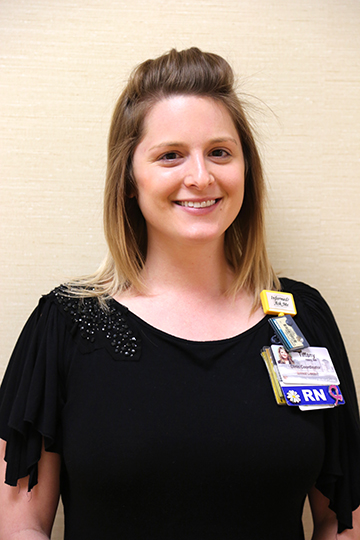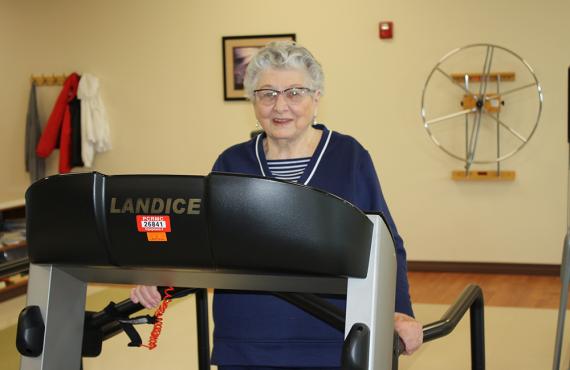Published on November 23, 2021
Read Time: Seven Minutes
Tiffany Henry, RN, Phelps Health Comprehensive Breast Center coordinator, discusses breast cancer awareness and the importance of getting screening mammograms.
Why is breast cancer awareness important?
“We've [raised awareness about breast cancer] for many years, but there are still a lot of women who do not get their annual mammogram. The last statistics that I saw [stated that] about 30% of women in Phelps County don't get their mammogram yearly. We need to encourage women to get [mammograms].”

What is breast cancer?
“Breast cancer is a type of cancer, where cells in the breast tissue divide and grow without the normal controls that stop the tissue from dividing and can cause some problems.”
What are the chances of a woman getting breast cancer?
“About one in eight women will get breast cancer within her lifetime.”
What are the different types of breast cancer?
“The basic or more common types…are ductal carcinoma in situ – cancers that haven't invaded outside of the ductal tissue or globular tissue – and invasive cancers. Ductal carcinoma begins in the ducts and they [spread out of the breast] if they become invasive. Globular carcinomas start in your globules, which is the breast-producing glandular tissue, and the ducts are what take the milk to the nipple.
“There's some other kinds [of breast cancer] called Phyllodes tumors, which begin in the connective tissue of the breast. There's Paget disease, which starts in the ducts and then [spreads] to the skin. There's inflammatory breast cancer…[involving] very hot and red skin changes, but that's actually a very rare type of breast cancer. It's actually pretty aggressive and seen a lot of times in younger women. Then, [there is] triple negative, which is also a very aggressive type of breast cancer.”
Does each type of breast cancer feel different?
“It [breast cancer] can present in all different types of ways. When women feel something, typically, what they’re feeling is a hard, small, non-movable mass. It's very firm. It almost feels like…a rock. Ideally, we don't want to be feeling anything. We want to detect it [breast cancer] early, so your treatment options are greater and you have a lot less treatment that you need.”
What are the risk factors for developing breast cancer?
“There are a lot of genes that you can inherit that can cause breast cancer. The more common ones or BRCA1 or BRCA2. If you have a family history [of breast cancer], you’re [likely] going to have this mutation. But actually, about 80% of women who have breast cancer don't have any family history at all. Other risk factors [include] being female. About only 1% of males develop breast cancer in their lifetime. As you get older, the more likely you are to develop breast cancer.”
What are the symptoms of breast cancer?
“Swelling, warmness, redness, skin dimpling or darkening, or a change in your breast size or shape [are symptoms of breast cancer]. Puckering of the skin [occurs when] the breast cancer is actually growing and it's retracting the tissue in and causing the dimpling. With Paget disease, sometimes you'll see itchy, scaly [skin or it will be] sore around the nipple. [You might have] nipple inversion. Nipple discharge is another thing that we sometimes see.
“We would recommend any new nipple discharge [or new pain] that you're having, you come in and have that evaluated. But actually the majority of women have no symptoms [of breast cancer] and we catch [breast cancer] on a screening mammogram.”
If someone has breast cancer, what are local treatment options?
“We have a fantastic cancer center and a great team of folks at the Delbert Day Cancer Institute. We have oncologists, radiation therapy and surgeons available. We have a whole multidisciplinary team who is there to help you.”
What is a mammogram?
“A mammogram is a low-dose X-ray that we use to obtain pictures of your breast tissue. We use compression to hold that tissue still, so we can get good imaging. The pictures go to the radiologist who reviews those and looks for breast cancer. Our [mammogram] machines actually…tell you the optimal level of compression for each breast. The techs [perform compression] very slowly and work with you to make it a comfortable experience.”
What is 3D mammography?
“3D mammography is a newer technology that allows us to take multiple images of your breast in different dimensions and different slices [and lets] us recreate a 3D image that the radiologist can flip through like a book and look at thin slices -- similar to…a CAT scan, where we can look at those thin slices of the breast tissue and identify abnormalities. They [3D mammograms] have about a 30% to 40% higher cancer detection rate. They are a great tool. They're very beneficial for women with dense breast tissue.”
Why do women have to get mammograms?
“Mammograms help us detect things early. A mammogram can detect breast cancer up to two years before you would ever be able to feel something, which is ideal. When you're feeling something, typically, that means that it is a more invasive cancer and you're going to need a lot more treatment. Getting that yearly mammogram reduces the risk that you would need more invasive treatment.”
When should women start getting screened for breast cancer?
“We recommend yearly after age 40. However, [we recommend earlier] if you have a first-degree family member -- mother, sister, daughter -- who developed breast cancer. We will recommend [you get screened] 10 years before your earliest first-degree family member had breast cancer, but not before age 25.”
How important are self-breast exams?
“We recommend breast self-awareness. That's knowing what your breast normally look and feel like. That involves feeling your breasts, doing an exam and having a good idea on a normal basis what they feel like, so you can report any changes that you see to your physician.”
What can women expect when they come to the Comprehensive Breast Center for a mammogram?
“You can expect friendly faces. We have a great team. I have some fantastic technologists who have many years of experience and who are more than willing to talk you through the experience [of getting a mammogram]. We bring you back to your own private area to change [into a gown]. We clean in between [patients]. We provide robes for you to be comfortable. We ask that you don't wear lotions, powders or deodorant. The deodorant can actually show up and can look like an abnormality on your mammogram.
“The test [screening mammogram] itself takes about 10 to 15 minutes, and then you're on your way. Diagnostic [mammograms] are going to take [about] an hour to an hour and a half. The radiologist normally speaks with you or you have an idea of your test results before you leave. If you need any further imaging, we would do that all the same day.”
What are the next steps if the tests indicates a potential concern?
“[The radiologist] will speak with you about your test results and make recommendations…if you would need a biopsy or if you would need to come back in six months for a follow-up.”
What services are offered at the Comprehensive Breast Center?
“We have screenings. We offer 3D imaging. We offer diagnostic imaging, breast ultrasounds and stereotactic biopsies. We’ve offered stereotactic biopsies for years, but we got a brand new 3D stereotactic biopsy unit thanks to the Auxiliary. They provided us with the funds to secure that amazing technology, and it is state-of-the-art. It’s much more comfortable than our old table. It's a prone table, so you lie on your stomach and your breast falls through a hole. The new technology makes the procedure much quicker.
“We also perform ultrasound-guided biopsies. We can do needle localizations pre-surgery, so if you have something that needs to be removed surgically, we localize the area for the surgeon. We perform galactograms (imaging of breast milk ducts) for nipple discharge.”
How can someone make an appointment with the Comprehensive Breast Center?
“If you have a MyChart account…you can make your own appointment. As long as you're not having any symptoms, you can make a screening mammogram appointment. If you need a diagnostic mammogram – if you have symptoms like breast pain and breast lump – you would need to go through your physician's office [for a referral]. Also, you can use Central Scheduling and call (573) 458-7737.”
Want to Know More About Mammograms?
To learn more about mammograms, breast self-awareness and general breast health, call Phelps Health’s Comprehensive Breast Center at (573) 458-3100.

